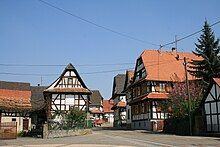Outre-Forêt
The Outre-Forêt ( Unteremwàld in Alsatian ) is a natural region in the north of Alsace , which borders directly on Rhineland-Palatinate . Outre-Forêt means "beyond the forest", which refers to the Hagenau forest . In the north it is bordered by the Bienwald and the Lauter river , in the east by the Petit Ried and the Rhine , in the west by the Northern Vosges and the Falkensteinerbach . Away from major roads and tourist routes, the Outre-Forêt has retained its traditions. There are numerous half-timbered houses, traditional pottery is also practiced and wine is grown in the vineyards .
geography
The Outre-Forêt is bordered by the Hagenau Forest in the south, the Bienwald in the north, the wooded Northern Vosges in the west and the Rhine in the east. In the east there is also the Petit Ried .
The Outre-Forêt stretches between the Lautertal and the sand-like alluvial cones of the Sauer and Moder rivers .
It is a hilly landscape, the height of which is modest: namely in Surbourg the height is 217 m above sea level. To the west, the Cleebourger vineyard has a slight slope. The Benedictine monks of Wissembourg Abbey had already planted wine in the Middle Ages.
Unlike the neighboring woods and pastures is a real farmland , which is thanks to the loamy top layer of the mixed culture.
history
The Maginot Line , such as the Schœnenbourg artillery plant , ran through the Outre-Forêt , the history of which is confused. There is a Musée de l'Abri ( protection ) in Hatten .
tradition

When the Hagenau Forest was still an obstacle, and before the car ushered in a new era of mobility, the area was remote. As a result, she knew better to maintain her traditions than anywhere else. The half-timbered houses here are white, unlike most of the Alsatian half-timbered houses which have been colored. In addition, Hunspach was recognized as one of the most beautiful villages in France . Namely, the building fabric has remained uniform. Even if this unity does not prevail everywhere, the villages are beautiful and decorated with flowers. On the occasion of the festivals (including the Streissel wedding in Seebach ), folk costumes are often put on. A museum for folk art and folk traditions in Kutzenhausen endeavors to reproduce rural life in the area at the beginning of the 20th century.
While Alemannic is mainly spoken in the rest of Alsace , South Franconian is spoken in the Outre-Forêt (Franconian is also spoken in crooked Alsace, but Rhine Franconian as in Northern Lorraine). The official language is French as in all of France.
L'Outre-Forêt is a regional magazine devoted to the history of the area.
economy
Pottery has been practiced here since the Neolithic. Betschdorf is known for its pottery. Gray is thanks to the clay, while cobalt gives the pottery blue.
The Merkwiller-Pechelbronn Oil Museum is a testament to the pioneering work that the area carried out in the field of the oil industry.
Nowadays, attempts are being made to exploit geothermal energy in Soultz-sous-Forêts thanks to the hot-dry-rock method .
literature
- Cercle d'histoire de l'Alsace du Nord: Journées portes ouvertes monuments historiques de l'Outre-Forêt, September 1991. 1991. (11 fiches sous pochette présentant des monuments à Lauterbourg, Soultz-Sous-Forêts, Altenstadt, Kutzenhausen, Preuschdorf , Wœrth et Walbourg)
- Cercle d'histoire de l'Alsace du Nord: Connaître et aimer l'Outre-forêt, circuits guidés. Delbecq, Reichshoffen 1984.
- Michel Charvet: Dessine-moi l'Alsace: l'Outre-Forêt. Editions J.-P. Gyss, Barembach / Schirmeck 1987, ISBN 2-902912-61-7 .
- J.-M. Hauer: Inventaire des synagogues du pays de Hanau et d'Outre-Forêt, contribution à l'étude de leur architecture par quelques examples détaillés. Strasbourg 1985. (mémoire d'Architecture)
- Claude Muller: L'Outre-Forêt au XVIII. siècle. Ed. Coprur, Strasbourg, 2004, ISBN 2-84208-105-6 .
- Daniel Peter: Les resources en eau de l'Outre-Forêt. In: Outre-Forêt. 57/1987, pp. 4-9.
- Daniel Peter: La faune aquatique dans l'Outre-Forêt, au XIX. siècle. In: Outre-Forêt. 57/1987, pp. 14-16.
- Daniel Peter: Naître, vivre et mourir dans l'Outre-Forêt (1648–1848). Cercle d'histoire et d'archéologie de l'Alsace du Nord, Wissembourg 1995. (texte remanié d'une thèse d'Histoire moderne)
- Jean-Laurent Vonau (dir.): L'Outre-forêt dans la tourmente révolutionnaire. 1989. (publié à l'occasion du Bicentenaire de la Révolution française)
- Elisabeth Weinling: Les anabaptistes d'Outre-Forêt 1700–1871. Université de Strasbourg 2, 1996. (mémoire d'Histoire)
Individual evidence
- ^ Outre-Forêt. In: Alsace. Gallimard, Paris 2007, p. 204.
- ↑ Le Carré magique , Association pour le développement de l'Alsace du Nord, p. 17.
- ^ Henri Nonn: Variété des paysages naturels et des écosystèmes. In: Alsace. Encyclopédie Bonneton, Paris 2001, p. 239.
- ↑ Jörg Baumgärtner: The European Hot Dry Rock Project at Soultz (PDF, 1.46 MB, English)



